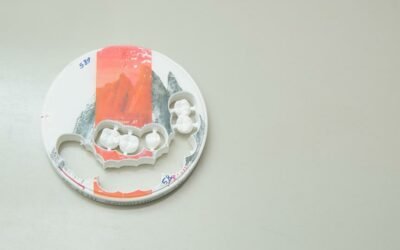Do you know what mold on raisins looks like?
In this article, we will explore the different types of mold that can grow on raisins and the characteristics that define moldy raisins.
You will learn how to identify the signs of mold growth, including the various colors it can manifest.
Additionally, we will discuss the proper way to dispose of moldy raisins to prevent any potential health risks.
Get ready to delve into the fascinating world of raisin mold!
Key Takeaways
- Mold on raisins can have different colors, such as black, green, white, or grayish-green.
- Moldy raisins may have a fuzzy or powdery growth on the surface and a musty or off-putting odor.
- Mold growth on raisins can result in a change in texture, making them soft, squishy, or slimy.
- Moldy raisins should be discarded, as they can contain mycotoxins that can cause allergic reactions and respiratory problems.
Different Types of Mold on Raisins
When examining mold on raisins, you can identify various types based on their appearance and characteristics. Mold is a type of fungus that grows in moist environments, and it can easily develop on raisins if they aren't stored properly.
One common type of mold found on raisins is Aspergillus. It appears as black or grayish-green fuzzy patches and can produce harmful toxins called aflatoxins.
Another type of mold that can grow on raisins is Penicillium. It typically appears as blue or green spots and can produce mycotoxins that may cause allergic reactions or respiratory issues.
Alternaria is yet another type of mold that can infect raisins. It's characterized by black or dark brown spots and can produce allergenic compounds.
Cladosporium is a type of mold that forms olive-green or brown colonies on raisins and can cause respiratory problems in sensitive individuals.
It's essential to discard any raisins that show signs of mold growth to avoid potential health risks.
Characteristics of Moldy Raisins
To identify moldy raisins, simply examine their physical features. Mold on raisins can have various characteristics that are indicative of its presence.
One key characteristic is the appearance of a fuzzy or powdery growth on the surface of the raisin. This growth can range in color from white, green, or black, depending on the type of mold present.
Additionally, moldy raisins may have a distinct musty or off-putting odor. This odor is caused by the metabolic byproducts of the mold, which can be detected even before visible signs of mold are present.
Another characteristic to look out for is a change in texture. Moldy raisins may become soft, squishy, or develop a slimy coating. This change in texture is a result of the mold breaking down the sugars and other nutrients in the raisin.
It's important to note that consuming moldy raisins can lead to health risks, as molds can produce toxins that are harmful when ingested. Therefore, it's crucial to discard any raisins that show signs of mold growth to ensure food safety.
Signs of Mold Growth on Raisins
Inspecting the raisins, you'll easily identify signs of mold growth. Mold on raisins typically appears as small, fuzzy patches that can range in color from green to black. These patches are caused by the presence of mold spores, which are microscopic fungi that thrive in moist environments. When mold spores come into contact with the sugars in the raisins, they begin to grow and multiply, leading to the formation of visible mold colonies.
One of the key signs of mold growth on raisins is a change in texture. Moldy raisins tend to become softer and mushy compared to their fresh counterparts. This is due to the enzymes released by the mold as it breaks down the raisins' organic matter. Additionally, mold growth can cause the raisins to develop a pungent odor. This smell is often described as musty or earthy.
It is important to note that consuming moldy raisins can be harmful to your health. Mold produces mycotoxins, which are toxic compounds that can cause allergic reactions and respiratory problems. Therefore, it's crucial to discard any raisins that show signs of mold growth.
Colors of Mold on Raisins
To determine the colors of mold on raisins, you can simply observe the patches that have formed on the surface. Mold can appear in various colors, each indicating a different type of mold and level of spoilage. Here are the colors of mold you may encounter on your raisins:
- White: White mold on raisins can be a sign of early-stage growth. It may appear as a thin, powdery coating on the surface. Although white mold is less common, it's still important to discard these raisins to prevent further contamination.
- Green: Green mold on raisins is relatively common and indicates a more advanced stage of spoilage. It may appear as fuzzy or velvety patches. These raisins should be discarded immediately, as the mold can produce toxins that may be harmful if consumed.
- Black: Black mold on raisins is a clear sign of extensive mold growth and should be avoided at all costs. It may appear as dark, slimy patches. Black mold can produce mycotoxins, which can cause adverse health effects if ingested.
How to Properly Dispose of Moldy Raisins
What is the proper way to dispose of moldy raisins?
When dealing with moldy raisins, it's important to handle them with care to prevent the spread of mold spores.
To properly dispose of moldy raisins, follow these steps:
- Containment: Place the moldy raisins in a sealable plastic bag or container to prevent the release of mold spores into the air.
- Disposal: Throw the sealed bag or container into a trash bin designated for organic waste. Don't compost moldy raisins, as they can contaminate the compost with mold spores.
- Cleaning: After handling moldy raisins, wash your hands thoroughly with soap and water to remove any potential mold spores.
By following these disposal guidelines, you can minimize the risk of mold contamination spreading to other food items or surfaces.
Remember to always inspect raisins before consuming to ensure they're free from mold growth. If you notice mold on a large portion of the raisins or if the mold appears to be a toxic mold, it's advisable to discard the entire package.
Moldy raisins can pose health risks, especially to individuals with allergies or compromised immune systems, so it's important to dispose of them properly.
Conclusion
In conclusion, identifying mold on raisins is crucial for ensuring food safety. Mold on raisins can appear in various colors, such as green, blue, or white. It's characterized by fuzzy or powdery growth on the surface of the raisins.
When encountering moldy raisins, it's important to dispose of them properly to prevent the spread of contamination. By being aware of the signs and characteristics of mold growth, individuals can make informed decisions to ensure the consumption of safe and healthy raisins.





0 Comments